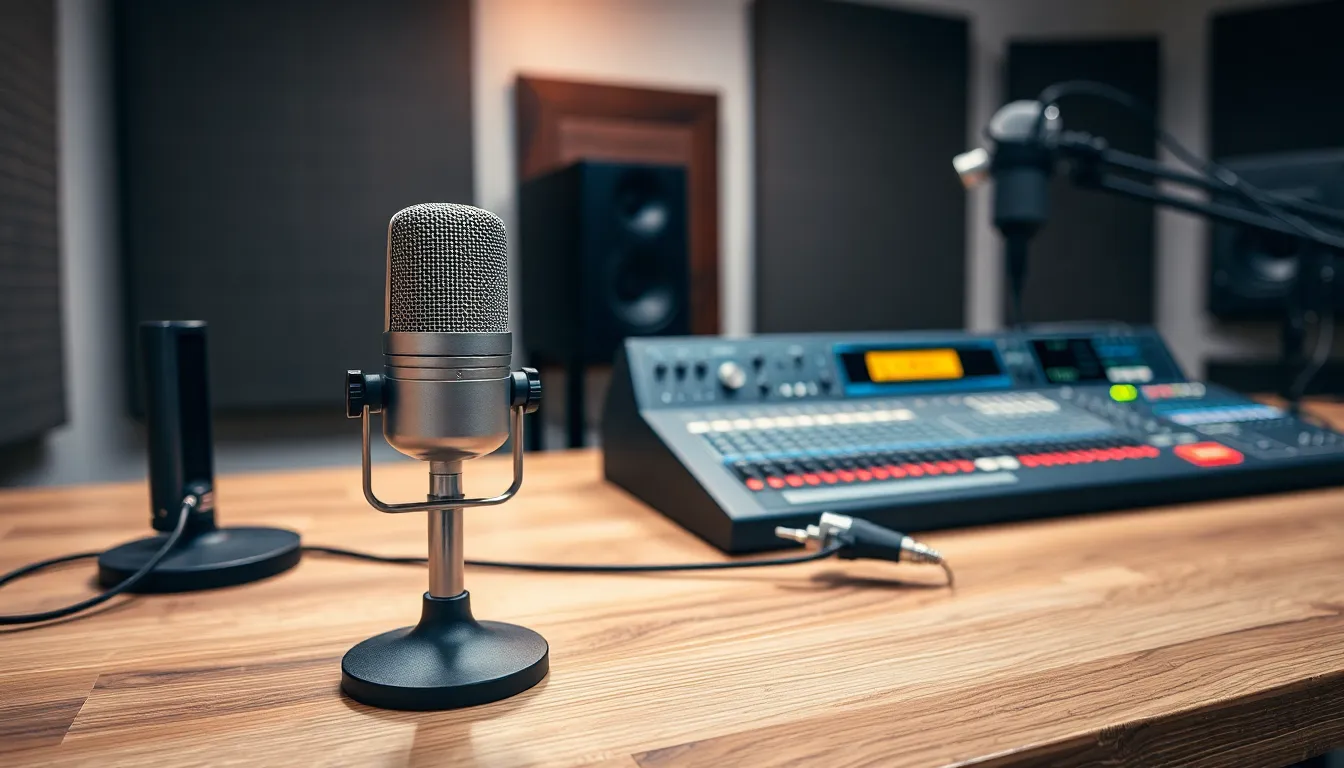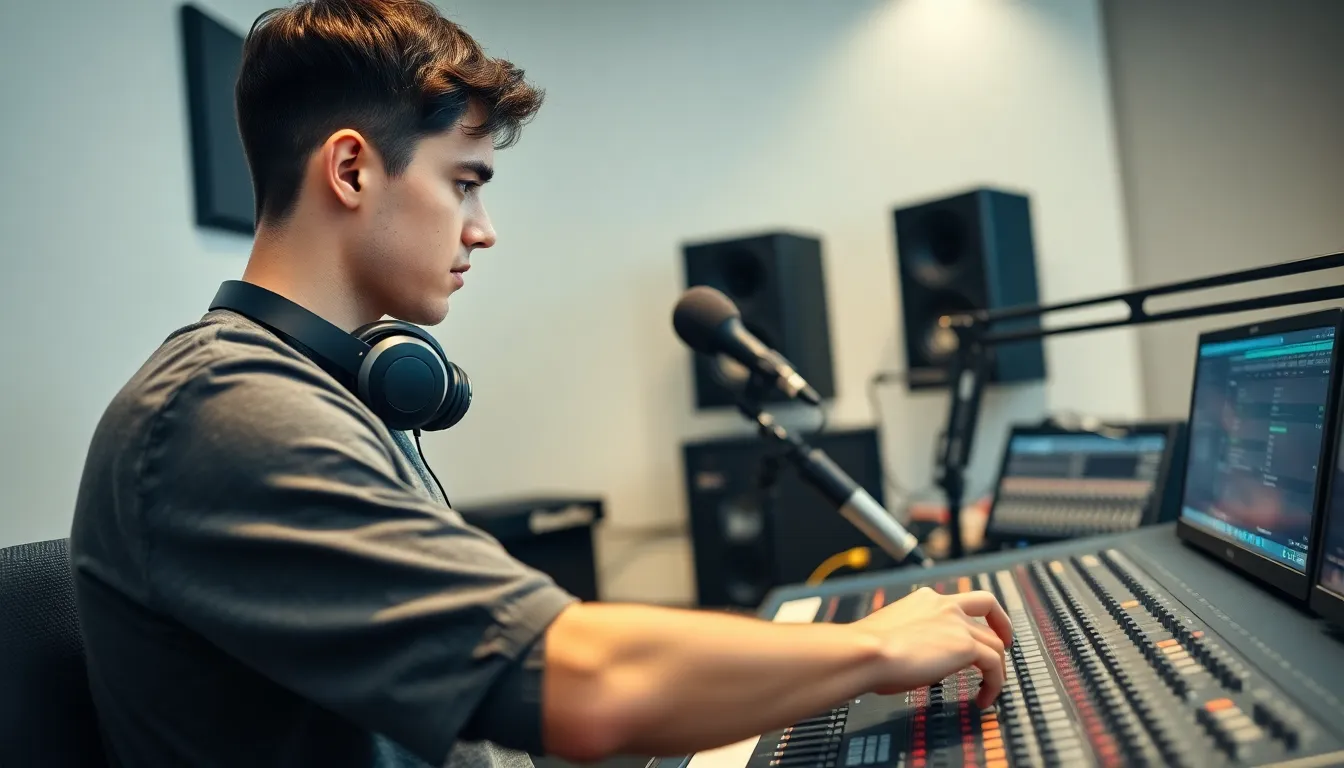In a world where everyone’s a DJ, audio engineering technology is the unsung hero behind the scenes, ensuring that music sounds just right. Imagine a universe where every note hits the ear like a perfectly cooked soufflé—light, airy, and oh so satisfying. This technology doesn’t just mix sounds; it creates experiences that can make you dance like nobody’s watching or cry in your car over that breakup song.
Table of Contents
ToggleOverview of Audio Engineering Technology
Audio engineering technology encompasses various techniques and tools used in sound recording, manipulation, and playback. It plays a vital role in shaping the music and entertainment industry while enhancing emotional engagement for listeners.
Digital audio workstations capture sound waves through software, enabling efficient editing and mixing processes. Microphone technology also advances with innovations that ensure accurate sound reproduction across diverse settings.
Signal processing incorporates effects like reverb and equalization, which modify sound quality and texture. These elements contribute to creating immersive audio experiences that resonate with audiences. Furthermore, mastering combines multiple tracks into a cohesive final product, ensuring consistent sound across various playback systems.
Production studios utilize high-quality monitors and headphones for accurate sound representation during mixing sessions. Professional engineers leverage their expertise to balance levels, adjust frequencies, and fine-tune dynamics, ultimately elevating the listener’s experience.
Advancements in audio engineering technology continue to transform how music is created and enjoyed. Innovations such as spatial audio and 3D sound environments provide new ways for audiences to engage with music. As technology evolves, the boundary between the artist and listener blurs, fostering deeper connections through sound.
The significance of audio engineering technology extends beyond music production. Many industries, including film, gaming, and broadcasting, rely on these advancements for compelling audio experiences. Overall, the progress in audio engineering drives creativity and emotional expression, establishing a powerful link between sound and human experience.
Key Components of Audio Engineering Technology

Audio engineering technology relies on several key components that shape the sound experience. Understanding these components proves vital for anyone involved in music production or related fields.
Microphones and Their Types
Microphones capture sound in various environments. Dynamic microphones are durable and handle high sound pressure levels, making them ideal for live performances. Condenser microphones offer higher sensitivity and detail, suitable for studio vocals and acoustic instruments. Ribbon microphones provide a smooth frequency response and warm sound quality often favored in studio settings. Selecting the right microphone type impacts sound quality and the overall recording atmosphere.
Audio Interfaces and Mixers
Audio interfaces connect microphones and instruments to computers, converting analog signals into digital formats. High-quality audio interfaces provide low latency and improved sound clarity. Mixers control audio levels and apply effects, allowing precise manipulation of multiple audio sources. They come in both analog and digital formats, with digital mixers offering advanced features like automation and built-in effects. Utilizing these tools fosters the creative process, enabling audio engineers to achieve polished final products.
Digital Audio Workstations (DAWs)
Digital Audio Workstations play a vital role in audio engineering technology, streamlining music production with advanced tools for recording, editing, and mixing sound. These platforms serve as the backbone of modern music creation, allowing producers to craft their visions with precision.
Popular DAWs in the Market
Several DAWs dominate the market today, including Ableton Live, Pro Tools, and Logic Pro. Ableton Live caters to electronic music producers with its session view and intuitive interface. Pro Tools remains a standard in professional studios, known for its robust editing capabilities and seamless integration with hardware. Logic Pro is favored by Mac users for its user-friendly design and comprehensive virtual instrument library. FL Studio also stands out, especially among beginners, due to its affordability and straightforward layout. These options provide unique features that address diverse production needs.
Features of Modern DAWs
Modern DAWs come equipped with an array of powerful features. Multi-track recording enables simultaneous capture of various audio sources, enhancing workflow efficiency. Advanced MIDI editing allows for intricate arrangements and personalized sound design. Additionally, built-in plug-ins offer effects and virtual instruments, further expanding creative possibilities. Cloud collaboration enables real-time sharing of projects among multiple users, streamlining teamwork across distances. Furthermore, user-friendly interfaces simplify navigation, making these platforms accessible to both beginners and experienced engineers.
Trends in Audio Engineering Technology
Audio engineering technology continuously evolves, driven by user demands and innovations. Emerging trends reshape the audio landscape, fostering creativity and improving sound quality.
Advances in Recording Techniques
Innovative recording techniques enhance fidelity and expand creative possibilities. Techniques such as acoustic treatment and advanced microphone placement improve sound capture quality. Binaural recording creates immersive listening experiences, making listeners feel as though they are inside the soundscape. Additionally, remote recording setups gain popularity, allowing collaboration across geographical boundaries. Equipment improvements, including portable audio interfaces and high-quality mics, facilitate these advancements, catering to both professionals and enthusiasts.
Impact of Artificial Intelligence
Artificial intelligence significantly influences audio engineering technology. AI-driven tools streamline mixing and mastering processes, enabling quicker turnaround times. Algorithms analyze sound patterns, offering recommendations for enhancements based on best practices. Moreover, AI-powered plugins simplify complex tasks, making advanced production techniques accessible to novice engineers. Enhanced recommendation systems optimize sound libraries, enabling engineers to discover relevant samples and sounds rapidly. This integration boosts creativity while maintaining audio quality, proving essential for modern audio production.
Audio engineering technology continues to revolutionize the way sound is created and experienced. Its impact stretches far beyond the music industry, influencing film, gaming, and broadcasting. As advancements in tools and techniques emerge, they foster greater creativity and emotional connection between artists and listeners.
The integration of AI and innovative recording methods is reshaping the audio landscape, making high-quality production more accessible. With each technological leap, the possibilities for immersive sound experiences expand, ensuring that audio engineering remains at the forefront of artistic expression. Embracing these changes is essential for anyone looking to thrive in this dynamic field.




